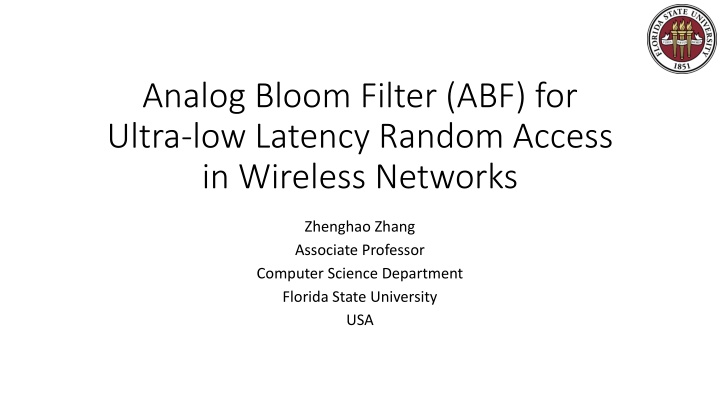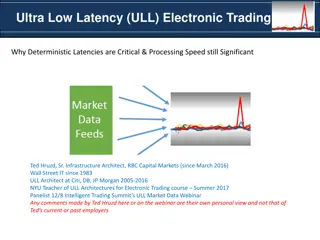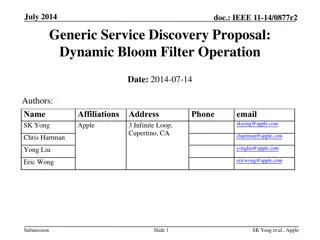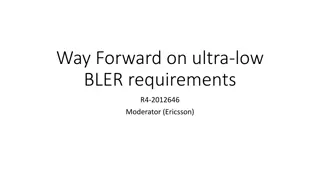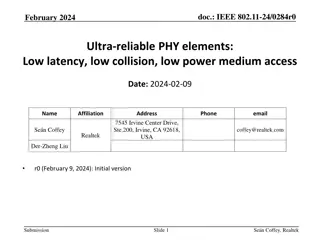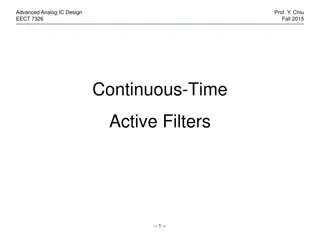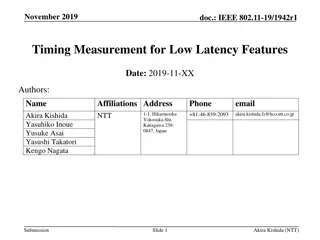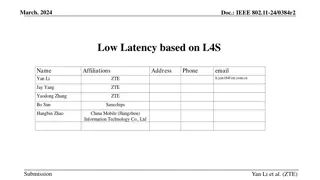Analog Bloom Filter for Ultra-low Latency Random Access
Analog Bloom Filter (ABF) is an efficient data structure for wireless networks, ensuring ultra-low latency random access. It addresses the challenge of efficiently storing information about existing items by using a compact M-bit vector. ABF utilizes OFDM subcarriers for transmitting information, allowing nodes to efficiently communicate their states. This innovative approach is particularly effective in scenarios with a limited number of active nodes, such as IoT applications in 5G networks, where low latency and frequent querying are crucial.
Download Presentation

Please find below an Image/Link to download the presentation.
The content on the website is provided AS IS for your information and personal use only. It may not be sold, licensed, or shared on other websites without obtaining consent from the author.If you encounter any issues during the download, it is possible that the publisher has removed the file from their server.
You are allowed to download the files provided on this website for personal or commercial use, subject to the condition that they are used lawfully. All files are the property of their respective owners.
The content on the website is provided AS IS for your information and personal use only. It may not be sold, licensed, or shared on other websites without obtaining consent from the author.
E N D
Presentation Transcript
Analog Bloom Filter (ABF) for Ultra-low Latency Random Access in Wireless Networks Zhenghao Zhang Associate Professor Computer Science Department Florida State University USA
Lets Start with Bloom Filter The Problem Suppose there are W items, among which only a small fraction actually exist. Want to have a data structure to store this information. Na ve solution: Keep a W-bit vector. 10000000100
Lets Start with Bloom Filter Solution Bloom filter: An efficient data structure for checking the existence of items, using only M (M << W) bits To set: For each item, generate K random numbers in the range [0,M-1]. If an item actually exists, set the corresponding K bits to 1. To check: An item exists only if all its K bits are 1
Lets Start with Bloom Filter Why It Works Works when the number of actual items is much smaller than the total number of possible items. Therefore, only a small fraction of bits are set Bloom filter has no False Negatives. If a small fraction of bits are set, the False Positive is also low.
Analog Bloom Filter Consider a wireless network supporting W nodes, each may want to announce some 1-bit information to the base station: I want to transmit some data I want to enter power saving mode I am back from the power saving mode I am a new comer, want to join your network send data want to join power saving
Analog Bloom Filter Analog Bloom Filter (ABF) is similar to the Bloom filter: Use M OFDM subcarriers as the M-bit vector in the Bloom filter Each node is assigned K subcarriers, and may transmit unit power on assigned subcarriers if it has something to say, otherwise silent
Analog Bloom Filter Key advantage: Just one OFDM symbol (or just part of the subcarriers in one symbol), will learn the states of all nodes in the network Again, it works when the number of active nodes is small True in the application scenario because not many nodes will turn active during two queries Good for 5G Number of nodes is very large with IoT Latency is very low, 1ms, have to query every 1ms
Challenges in Decoding the ABF signal That s it? Not really. The main challenge is the decoding of the signal The signal power on different subcarriers are different Frequency selective fading The decoder does not know the channel state information (CSI) Note that the node may sit idle for a long time and this is the first message it sends, so nothing to learn the CSI from
Challenges in Decoding the ABF signal Amplitude of some 20 MHz measurements 256 subcarriers, 8 active nodes, K=8
BelFix Energy-based Decoding Without CSI, decision based on energy: If seen enough total energy from the subcarriers assigned to a node, the node should be active If a node is active, it will pump energy into the air, and although some subcarriers may be weak, there are most likely some strong ones Enough energy
BelFix Challenge The challenge is that a subcarrier may be assigned to multiple nodes, how to determine how much energy is contributed by a node?
BelFix The Intuition B A Among the rest of subcarriers assigned to A and B, if very low energy for B but higher energy for A, it makes sense to guess that the energy on this subcarrier is contributed more likely by B, not A. In other words, the energy from other subcarriers is the belief of other subcarriers on the node.
BelFix The core of BelFix is a loop, which is mainly calculating this for all nodes and subcarriers: \? ??? ?= ?? \? ? ? +?? where: ?? ?: the amount of credit node i should get from subcarrier j ?: the total credit of subcarrier j ?? from subcarrier j ? positive credits Basically, it says that the credit a node receives from a subcarrier should be proportional to what it receives from other subcarriers \?: the amount of credit node i should get except +: the set of nodes assigned with subcarrier j with
BelFix Some Details Initially, all nodes assigned to a subcarrier equally receive credits Every 4 iterations, check the node with the highest total credit, and marks it as active if the credit and the number of subcarriers with positive credits are both high Once a node is marked active, all subcarriers assigned to it will be removed
BelFix -- Convergence Theorem. When all nodes have nonnegative credits, the change of credit any node receive from any subcarrier in iteration i is only a fraction of that in iteration i-1, therefore the convergence is exponentially fast.
BelFix -- Complexity Complexity is low, because the main calculation is just the credit update equation seen before: \? ??? ?= ?? \? ? ? +??
BelFix -- Implementation Implemented both on Matlab and the Microsoft SORA Software Defined Radio
BelFix Real-World Example (1) Total 12 active nodes. Subcarriers assigned to 3 nodes have been highlighted: Node 107, high power Node 295, low power, Node 476, high power
BelFix Real-World Example (2) Two subcarriers were assigned to two active nodes: Subcarrier 99 was assigned to both nodes 295 and 476 Subcarrier 150 was assigned to both nodes 107 and 295
BelFix Real-World Example (3) Convergence of these two subcarriers At the beginning, same Then quickly converges Node 295 receives less credit than the high power nodes
BelFix -- Performance Evaluated with both wireless channel model (802.11n model E) and experiments on the implementation with Microsoft SORA SDR 512 total associated nodes, 256 subcarriers The False Positive and False Negative Ratios are around 10-4 under typical conditions False Positive: says an idle node active False Negative: says an active node idle
BelFix Evaluations with Channel Model Varying the SNR and the number of active nodes (N) When N <= 12 and SNR >= 15 dB, FP and FN around 10-4 or lower When N= 16, still works, N=20 exceeds the capacity
BelFix Evaluations with Channel Model Comparing with: SMACK [Sigcomm 2009]: each node is assigned dedicated 1 (SMACK_1) or 2 (SMACK_2) subcarriers NAI: a na ve decoding algorithm, a node is active if all subcarriers are above a threshold Observations: SMACK_1 does not work, FN very high NAI does not work, FN very high SMACK_2 works well, but 4 times overhead
BelFix Evaluations with SDR Implementation General trends are similar as simulations Performance is worse mainly due to Using 1 antenna instead of 3 Some interferences in hardware Still confirming the practicability of ABF and the BelFix algorithm decoding ABF signal from more than one machine simultaneously at a reasonable error ratio in real time even with a software implementation in around 5 ms
Usage Case A Highly Efficient MAC Protocol The Access Point (AP) will 1. Use ABF to learn the set of nodes with data to send 2. Use another method called CFM to learn how much data the nodes have 3. Schedule data transmissions Advantage: with very low overhead, the AP knows the complete queue states of the nodes, can better schedule transmissions
Contention-Free Multi-bit Query (CFM) Allowing the AP to Obtain Multiple Bits So, how many bits you want to send? CFM allows the AP to poll a small set of nodes, but getting multiple bits from each node with one or part of one OFDM symbol 18 subcarriers per node in the current design, so also very low overhead Activate a subset of the assigned subcarriers according to a code
CFM Encoding and Modulation 6 groups, each 3 neighboring subcarriers The subcarriers are activated based on the code symbol value The binary of the symbol value + 1 The code is (6,4) RS code on GF(7) The codeword: [1, 5, 6, 3, 2, 2] The generator matrix of the code
CFM Decoding High Level Decode for each node individually 1. For each group, calculate a cost for each possible symbol value 2. Choose the codeword with minimum total cost symbol Cost symbol Cost 0 2 0 1 1 0 1 1 2 1 2 0 3 2 3 3 4 3 4 2 5 1 5 2 A CFM Symbol with 13 nodes 6 2 6 1
CFM Decoding Symbol Value Cost Calculation Do not have CSI, but the neighboring subcarriers should have similar amplitude Two cases: A subcarrier that should not be activated: the power value A subcarrier that should be activated: the difference of its power value with the average power value of all subcarriers that should be activated Symbol value 4: |0.2-0.6|+0.8+|1-0.6| = 1.6 Symbol value 5: 0.2+|0.8-0.9|+|1-0.9| = 0.4 Example: 0.2, 0.8, 1, the most significant subcarrier is the last
CFM Decoding Symbol Value Cost Calculation Theorem. Under a set of assumptions (details in the paper), the expected cost of the actual symbol value will be lower than that of other symbol values.
CFM Performance Evaluated with 802.11n model E When the SNR is 14 dB or above, lower than 10-4
Can Use CFM to Obtain for Free: weak strong An estimate of the channel states of each node An estimate of the propagation delay of each node
Muqmac: An Efficient Centralized Medium Access Protocol Centralized Considers only uplink here A typical cycle of the protocol
Implementation on the Microsoft Sora SDR Over 5,000 lines of C++ code, including ABF and CFM The medium access control sequence code A simple link layer protocol to cope with packet loss A simple scheduling algorithm
Overcoming Technical Challenges Synchronization the nodes need to respond to the query simultaneously, without timestamps of samples, relied on using identical software and hardware and a trigger packet from the AP Decoding ABF used a dedicated thread for decoding ABF signal, typically 5 ms, schedule data transmissions while decoding Reducing hardware errors pre-modulated packets of certain sizes, when transmitting a data packet, pick the closest one with larger size Virtual node have only 1 machine as the AP and 2 machines as the nodes. A machine host many nodes, the signal is the addition of all nodes in the machine
Muqmac Performance Compared method, implemented on ideal simulators with no PHY error Wi-Fi FICA [ACM Sigcomm 2010] D-Fi [IEEE Trans. Mob. Comput., 2015] dcD-Fi: without Machine Learning decoding iD-Fi: ideal case assuming no decoding error Hardware speed: 6 Mbps as an upper bound
Traffic Three 5-sec traces traffic at http://www.winlab.rutgers.edu/ ergin/mobicom2007/
Throughput Comparison jMuqmac: removing platform-specific overhead trigger packets difference between premodulated packets and data modulation time of query and query response For traffic 2 and 3: Muqmac is much higher, despite packet loss, query loss, and the overhead jMuqmac is over 75% and 90% of the PHY speed, respectively
Latency Comparison The latency with Muqmac is reasonably small Despite of the additional packet losses and overhead in the testbed The average latency of Muqmac is comparable with FICA and iD-Fi The latencies of FICA and iD-Fi are much more polarized
